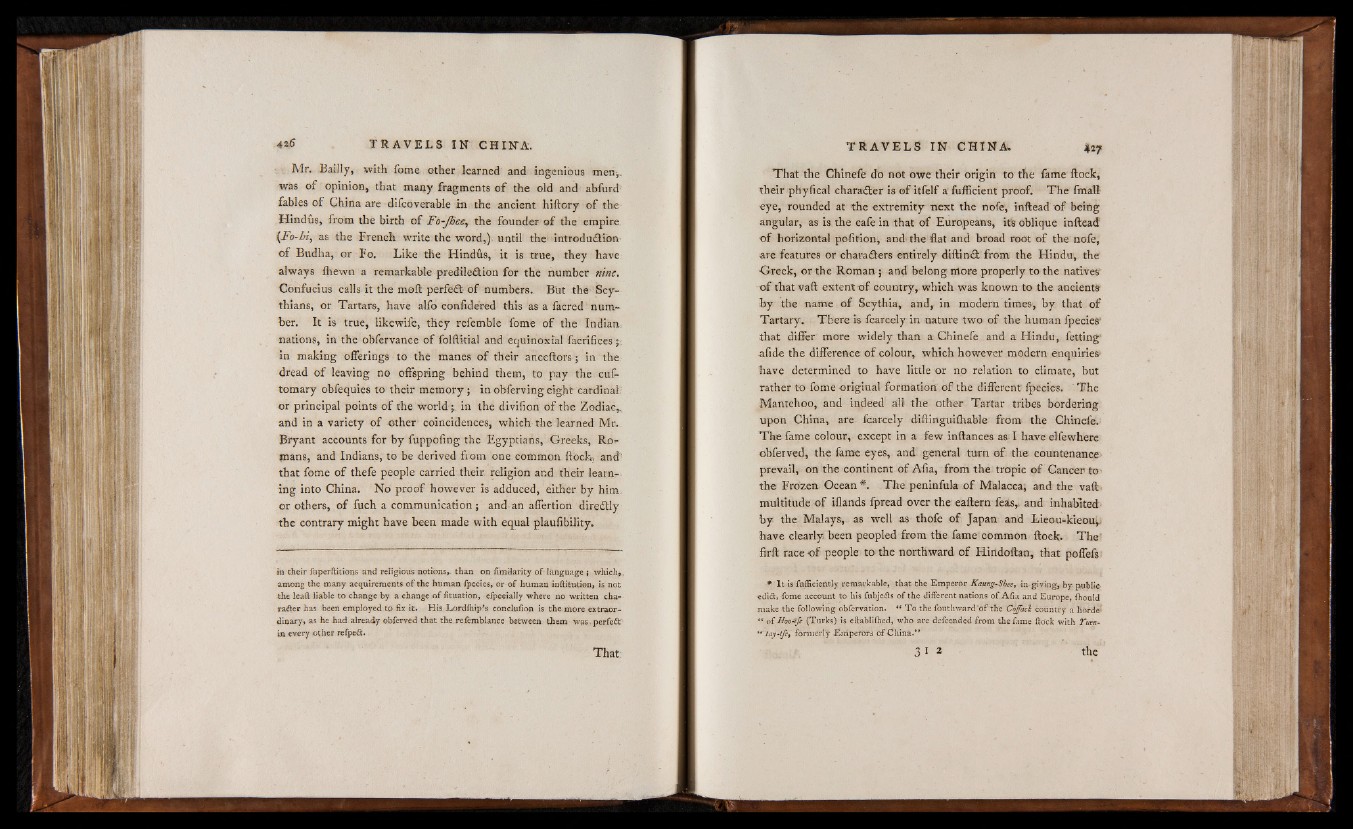
Mr. Bailly, with fome other learned and ingenious men-,,
was o f opinion, that many fragments o f the old and abfurd
fables o f China are diicoverable in the ancient hiftory o f the
Hindus, from the birth o f Fo-Jheer the founder o f the empire
(Fo-hi, as the French write the word,) until the introdudibn
o f Budha, or Fo. Like the Hindus, it is true, they have
always ihewn a remarkable prediledion for the number nine.
Confucius calls it the moft perfed o f numbers.. But the Scythians,
or Tartars, have alfo confidered this as a facred number.
It is true, likewife, they refemble fome o f the Indian,
nations, in the obfervance o f folftitial and equinoxi'al facrifices
in making offerings to the manes o f their anceftors; in the
dread o f leaving no offspring behind them, to pay the c u t
tomary obfequies to their memory; in obferving eight cardinal
or principal points o f the w or ld ; in the divifion o f the Zodiac*
and in a variety o f other coincidences, which the learned Mr.
Bryant accounts for by fuppofing the Egyptians, Greeks, R o mans,
and Indians, to be derived fiom one common flock, and’
that fome o f thefe people carried their religion and their learning
into China. No proof however is adduced, either by him,
or others, o f fuch a communication; and-an affertion diredly
the contrary might have been made with equal plaufibility.
in their fuperftitions and religious notions,, than on fimilarity of language ; which,
among the many acquirements o f the human fpecies, or of human inftitution, is not
the leaft liable to change by a change o f fituation, efpeeially where no written cha-
rafter has been employed to fix it. His Lordihip’s conclufion is the. more extraordinary,
as he had already obferved that the refemblance between them was . perfeft'
in every other refpe<5t.
That the Chinefe do not owe their origin to the fame ftock,
their phyfical charailer is o f itfelf a fufficient proof. The fmall
eye, rounded at the extremity next the nofe, inftead o f being
angular, as is the cafe in that o f Europeans, its oblique inftead
o f horizontal pofition, and the fiat and broad root o f the nofe,
are features or charafters entirely diftin£t from the Hindu, the
Greek, or the Roman ; and belong irtore properly to the natives
o f that vaft extent o f country, which was known to the ancients
b y the name o f Scythia, and, in modern times, by that o f
Tartary. There is feared y in nature two o f the human fpecies'
that differ more widely than a Chinefe and a Hindu, fetting'
afide the difference o f colour, which however modern enquiries
have determined to have little or no relation to climate, but
rather to fome original formation o f the different fpecies. The
Mantchoo, and indeed all the other Tartar tribes bordering
upon China, are fcarcely diftinguiihable from the Chinefe.
The fame colour, except in a few inftances as I have elfewhere
obferved, the feme eyes, and general turn o f the countenance
prevail, on the continent o f Afia, from the tropic o f Cancer to
the Frozen Ocean *. T he peninfula o f Malacca; and the vaft
multitude o f iilands fpread over the eaftern feas* and inhabited
b y the Malays,, as well as thofe o f Japan and Lieou-kieou;,
have clearly, been peopled from the feme common ftoek. The
firft race o f people to the northward o f Hirtdoftan, that poffefs
* I t is fufficiently remarkable, that the Emperor Kaung-Shee, in giving, by public
edidt, fome account to his fubj‘e<fts o f the different nations o f A fia and Europe, ihould
make the following obfervátion. “ T o the fouthward 'o f the Cojfách country a hórd#
*f o f Hovxfe (Turks) is eftabliihed, who are defcended from the fame ftock with Tutn-
ie tay-tfe, formerly Emperors o f China.*'
3 1 2 the